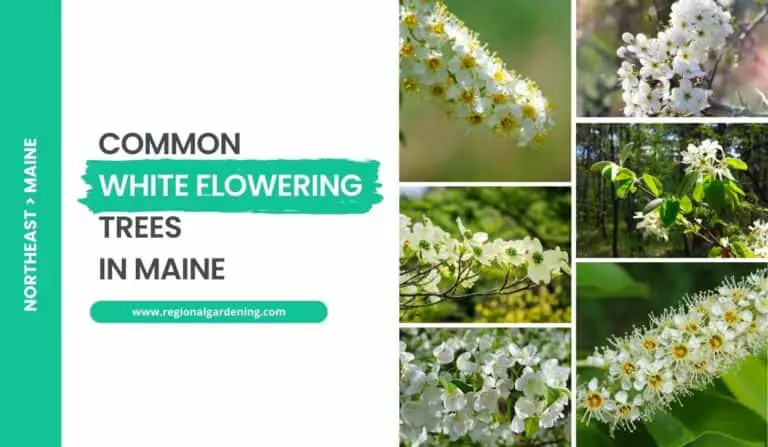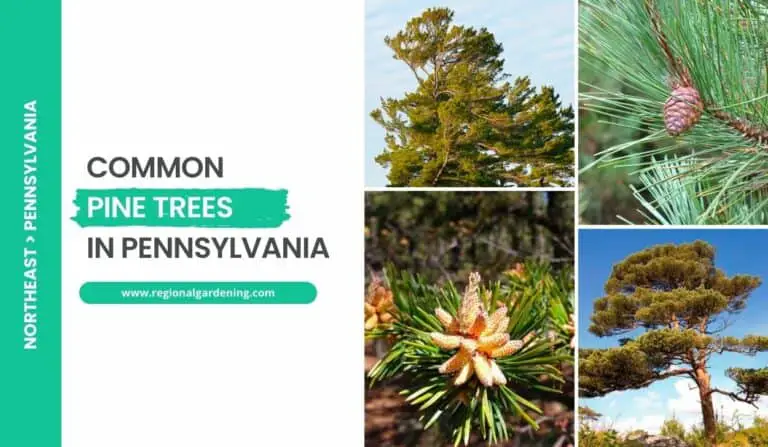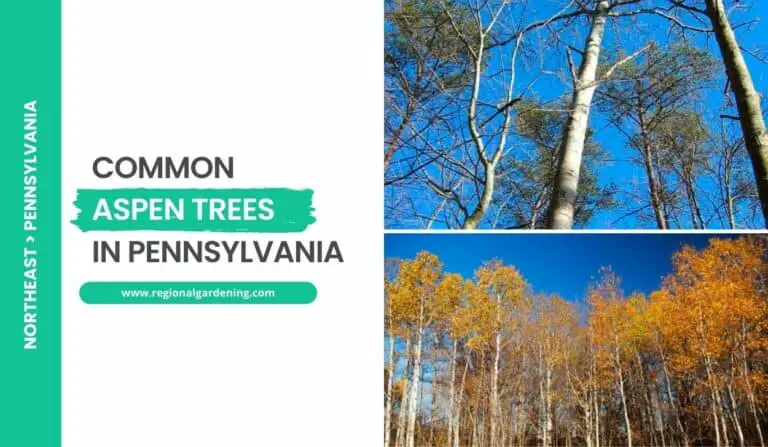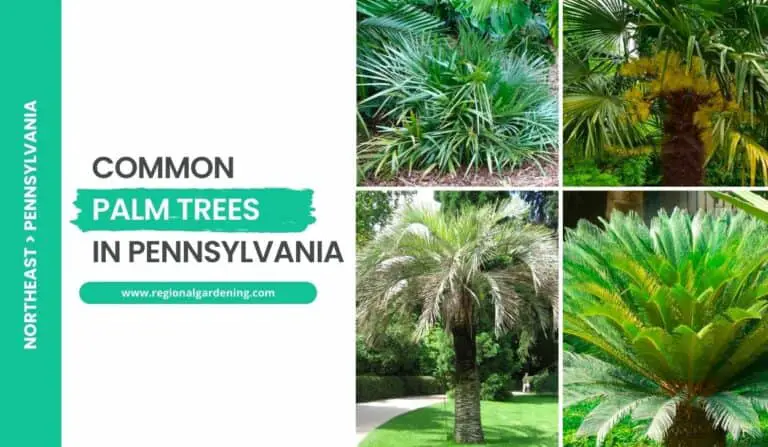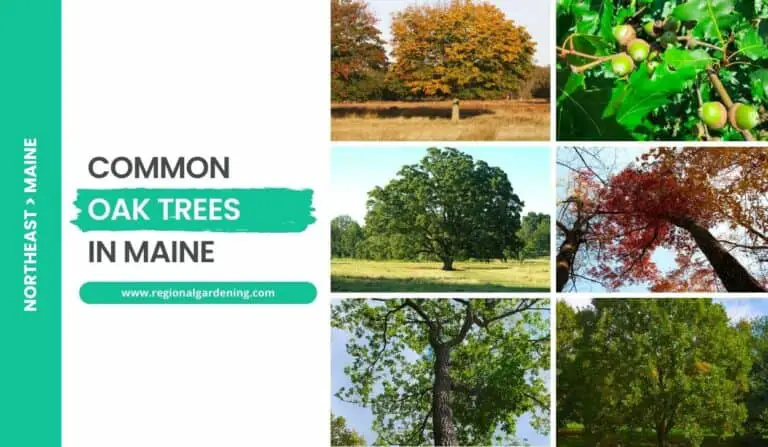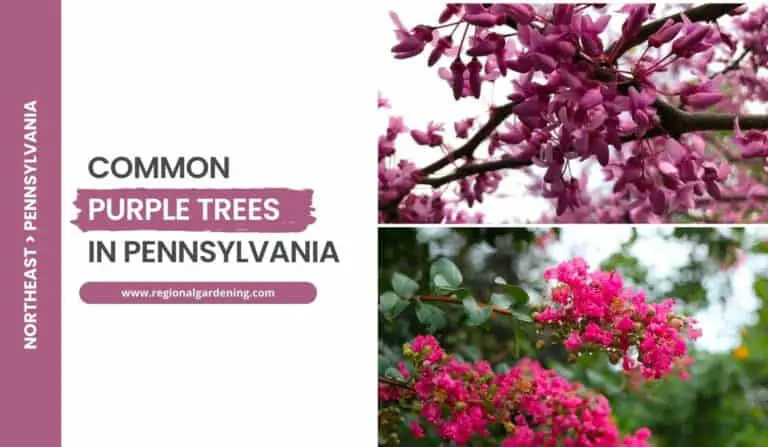21 Common Flowering Trees In Pennsylvania (Pictures & Care Tips)
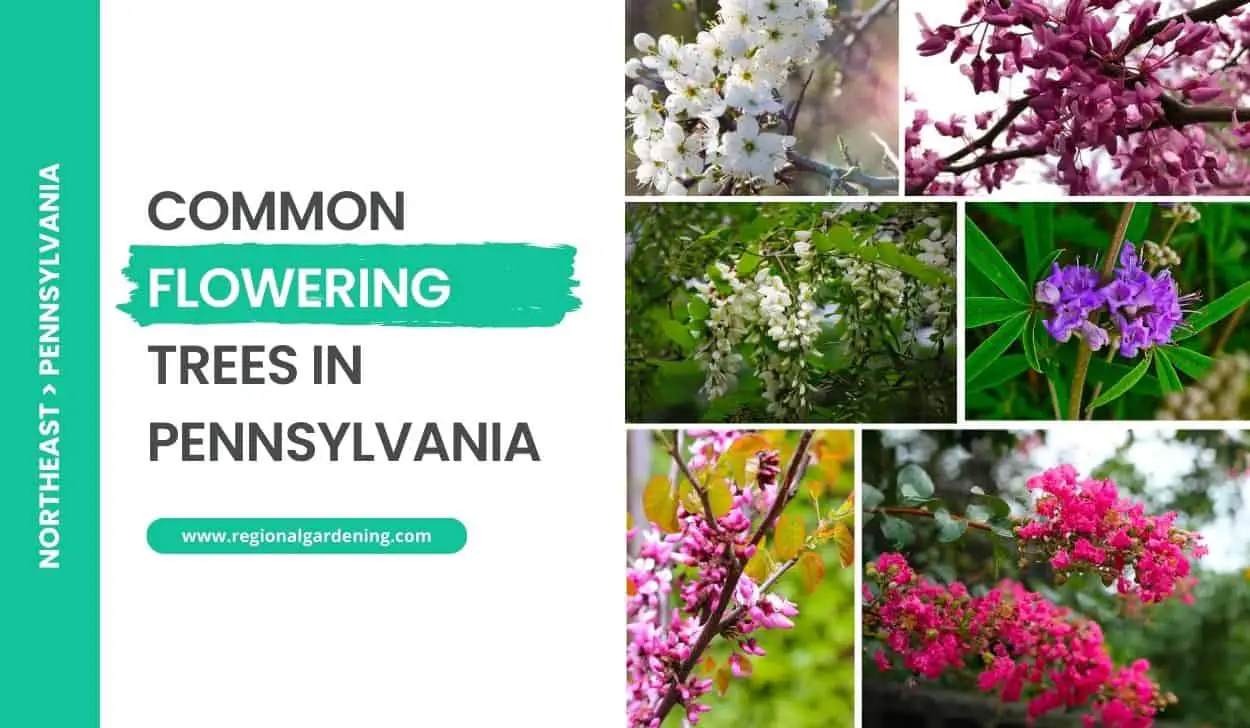
The vibrant colors and fragrant blooms of flowering trees bring life to Pennsylvania’s landscapes, each a testament to the state’s natural beauty. In this article, we will look at the 21 most common flowering trees in Pennsylvania and take a fascinating journey through the Keystone State’s blossoming treasures.
These arboreal wonders adorn Pennsylvania’s parks and gardens, enchanting all who come into contact with them, from the iconic Dogwood to the majestic Redbud and delicate Cherry Blossom.
Discover the secrets of these blooming beauties and bring the splendor of nature closer to home. So, let’s begin with the flowering dogwood, the most common of all flowering trees in Pennsylvania.
1. Flowering Dogwood
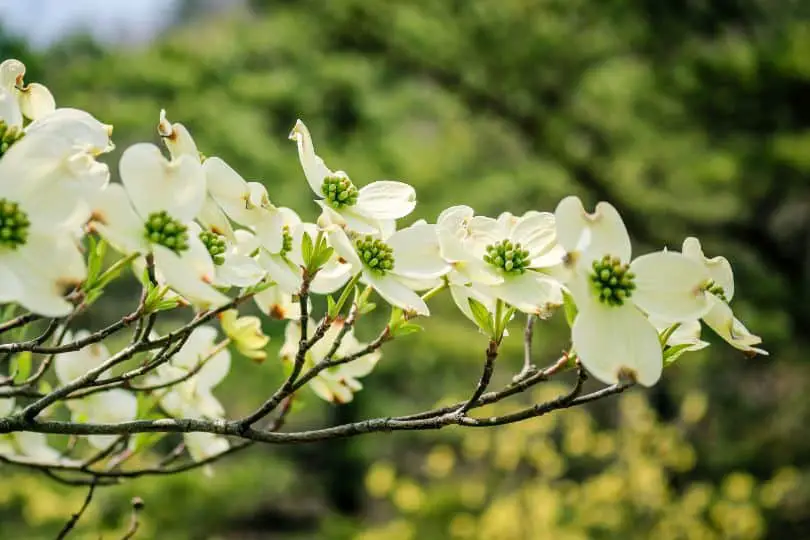
- Scientific Name: Cornus florida
- Common Name(s): Flowering dogwood
- Mature Height: 15-30 feet (4.5-9 meters)
- Native Region: Eastern North America
- Flowers: White or pink, small and clustered, with four rounded petals
- Fruit: Bright red, berry-like fruits
- Uses: Ornamental tree, wildlife habitat, and medicinal uses exist in some Native American traditions
Flowering Dogwood is a small to medium-sized deciduous tree native to eastern North America, including Pennsylvania. It grows to a mature height of 20-40 feet (6-12 meters) with a broad, rounded canopy.
The tree is well-known for its magnificent white blooms that bloom in the spring and have four enormous petals that are frequently mistaken for petals. Brilliant red berries that attract birds and other wildlife follow the blossoms.
Flowering Dogwood is a popular decorative plant in Pennsylvania settings due to its lovely blossoms and fall leaves. It enjoys partial shade to full sun and grows best in well-drained, acidic soil. This tree is low-maintenance, although it does need to be watered regularly, especially during dry seasons, to establish and maintain healthy development.
Flowering Dogwood can be found in wooded areas and along forest margins. It is frequently utilized in landscaping to give shade and beautify gardens, parks, and residential areas. The tree’s dense, horizontal branches and rough bark make it a good choice for attracting wildlife and adding aesthetic interest.
Flowering Dogwood is also recognized for its therapeutic benefits. Traditional medicine has employed the tree’s bark and fruit to cure colds, fevers, and respiratory problems.
2. Cucumber Magnolia
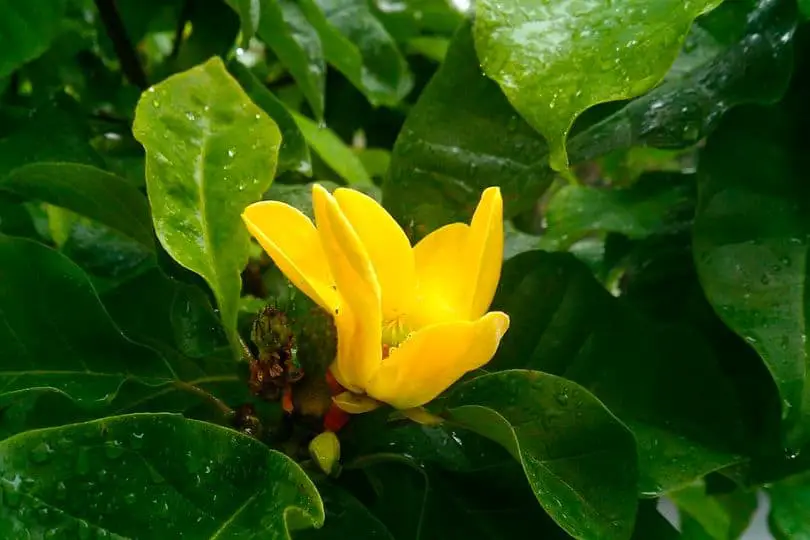
- Scientific Name: Magnolia acuminata
- Common Name(s): Cucumber Magnolia, Cucumber Tree
- Mature Height: 60-90 feet (18-27 meters)
- Native Region: Eastern United States
- Flowers: Bi-colored, tulip-shaped flowers in shades of yellow-green and cream
- Fruit: Cone-like fruit composed of red seeds
- Uses: Ornamental tree, shade tree, timber production, wildlife habitat
Magnolia acuminata, or Cucumber Magnolia, is a medium to large-sized deciduous tree endemic to the eastern United States, including Pennsylvania. It grows to a mature height of 60 to 90 feet (18 to 27 meters) and has a pyramidal shape while young, attaining a rounded crown with age. Cucumber Magnolia leaves are dark green and rectangular, with a prominent pointed tip, and turn yellow in the fall before dropping.
The blossoms of the Cucumber Magnolia are one of its most noticeable characteristics. The flowers have a greenish-yellow base with creamy white petals. They have a tulip-like shape and can grow to be 3 to 4 inches long. The blooms bloom in early spring, before or alongside the appearance of the leaves, making for a spectacular spectacle. This tree is widely regarded as one of the most beautiful flowering trees in Pennsylvania settings.
Following flowering, the Cucumber Magnolia develops cone-like fruit with vivid red seeds. These seeds provide a vital food supply for a variety of birds and small mammals, adding to the tree’s significance as a wildlife habitat.
Cucumber Magnolia grows in well-drained, wet soils and can survive a wide range of pH values in Pennsylvania landscapes. It prefers direct sunlight to slight shade. Once established, this tree requires little care because it is resistant to most pests and diseases. Because of its lovely blossoms and overall visual appeal, it is often employed as an ornamental tree in parks, gardens, and larger landscapes. Furthermore, the wood of the Cucumber Magnolia is employed for lumber manufacturing due to its strength and longevity.
3. Redbud
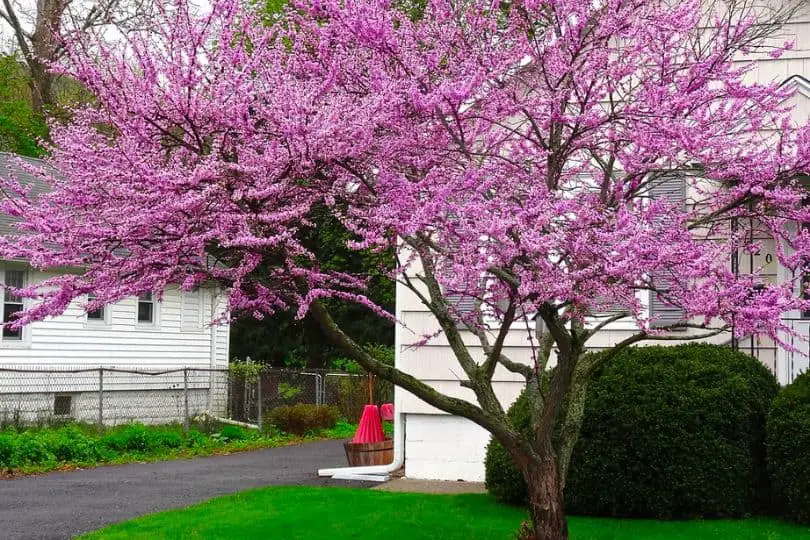
- Scientific Name: Cercis canadensis
- Common Name(s): Redbud
- Mature Height: 20 to 30 feet (6 to 9 meters)
- Native Region: North America
- Flowers: Pink or purple, pea-like flowers that bloom in early spring before the leaves appear.
- Fruit: Flattened, brown pods that ripen in late summer and persist through winter.
- Uses: Adds ornamental value to landscapes, attracts pollinators like bees and butterflies, and can be used for erosion control.
The Redbud tree, scientifically known as Cercis canadensis, can be found in many Pennsylvania landscapes. It is a deciduous tree that grows to a height of 20 to 30 feet, making it an excellent choice for compact yards. The Redbud tree is native to North America and can be found growing in a variety of settings, including woods and rocky slopes.
The Redbud tree’s early spring blossoms are one of its most notable characteristics. The tree is covered in clusters of small, pink, or purple pea-like blooms before the leaves grow. These vivid flowers not only give beauty to the landscape but also provide food for pollinators such as bees and butterflies.
The Redbud tree produces flattened, brown pods that store the tree’s seeds in late summer. During the winter, these pods offer visual interest to the tree and can also serve as a food source for birds. However, it is important to note that people don’t typically eat the pods.
Growing Redbud trees in Pennsylvania settings require well-draining soil and full sun to light shade. They may grow in a variety of soil types, but they flourish in damp, nutritious soil. Watering should be done regularly, especially during dry spells. Pruning is also necessary to keep the tree in shape and promote healthy growth.
Redbud trees have some utilitarian uses in addition to their aesthetic value. Because of their large root system, they can be utilized to control erosion. Redbud tree wood is rarely commonly used, although it can be used for tiny woodworking projects such as manufacturing tool handles or decorative things.
4. Sassafras
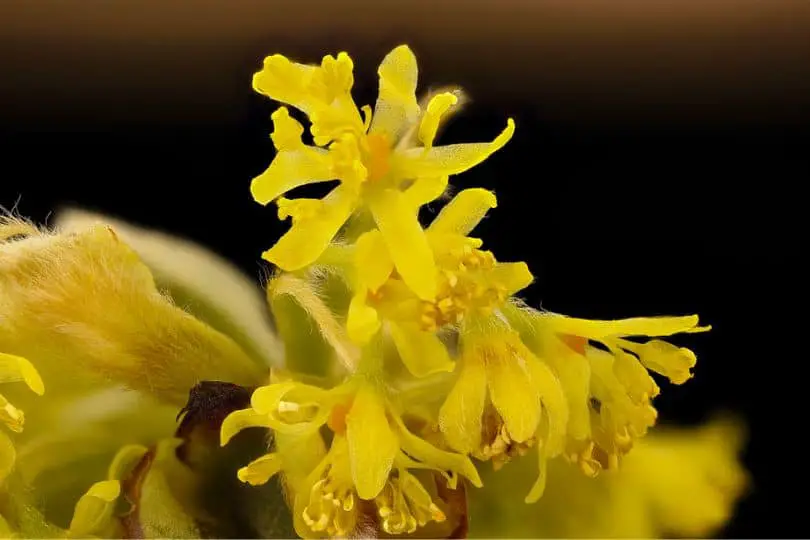
- Scientific Name: Sassafras albidum
- Common Name(s): Sassafras
- Mature Height: 30-60 feet (9-18 meters)
- Native Region: North America
- Flowers: Small, yellow-green flowers in early spring.
- Fruit: Dark blue-black berries in the fall.
- Uses: The bark, leaves, and roots of sassafras have been used for culinary, medicinal, and aromatic purposes. The leaves are used to make a tea with a distinct flavor, and the root bark is used as a flavoring agent in root beer and other beverages. The wood is used for furniture, cabinets, and musical instruments.
Sassafras is a deciduous tree that can reach heights of 30-60 feet. It features a circular crown with horizontally spreading branches. Sassafras leaves are distinctive in that they appear in three different shapes: oval, mitten-shaped, and three-lobed. The bark is smooth and reddish-brown in hue, with vertical furrows that grow with age.
Sassafras is a North American native that can be found in the eastern United States, including Pennsylvania. It can be found in wooded regions, along roadsides, and in disturbed places. Sassafras is adaptable to a wide range of soil types but favors well-drained soil.
Sassafras blooms in early spring, with little yellow-green flowers arranged in clusters. These blooms are not extremely attractive, yet they are essential for pollination. Because the trees are dioecious, there are male and female trees. Female plants produce dark blue-black berries in the fall that are appealing to birds.
Sassafras is a low-maintenance plant that requires little pruning. It enjoys full sun to partial shade and tolerates a wide variety of pH levels in the soil. Most pests and illnesses do not affect the tree.
Sassafras can be planted as an ornamental shade tree or as part of a naturalized landscape in Pennsylvania. It has gorgeous fall foliage with leaves that turn yellow, orange, and red. The pleasant perfume of the tree’s leaves and bark provides another dimension of fascination. Sassafras bark, leaves, and roots have a variety of applications. The dried leaves can be used to make a unique-tasting tea, while the root bark can be utilized to flavor beverages such as root beer. Sassafras wood is light and is used to manufacture furniture, cabinets, and musical instruments.
5. Black Cherry
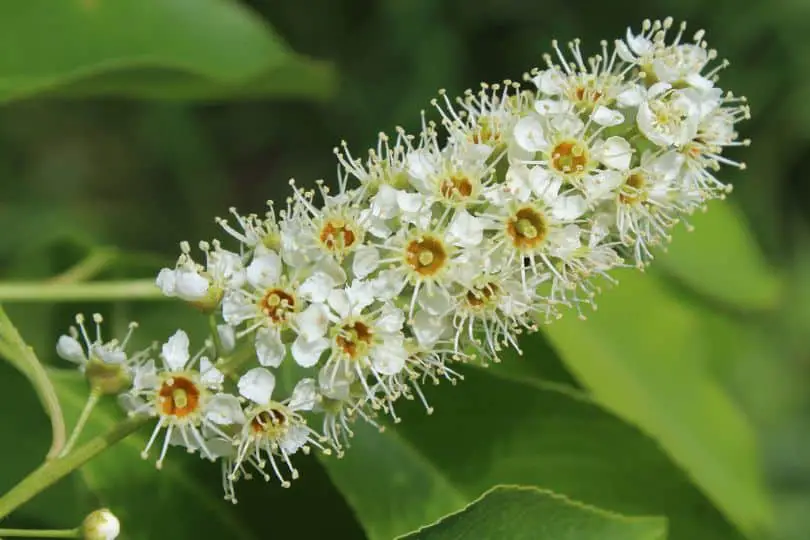
- Scientific Name: Prunus serotina
- Common Name(s): Black Cherry, Wild Cherry, Rum Cherry
- Mature Height: 50-90 feet (15-27 meters)
- Native Region: North America
- Flowers: Small, white flowers in elongated clusters
- Fruit: Dark red to black cherries
- Uses: The wood is valued for cabinetry, furniture, and veneer; cherries are edible and used for making jams, pies, and wine; the tree provides an important wildlife habitat and food source.
The Black Cherry (Prunus serotina) tree is endemic to North America, including Pennsylvania. It can grow to a mature height of 50 to 90 feet (15 to 27 meters) and is well-known for its lovely white blossoms and dark crimson to black cherries.
The smooth, dark gray bark of this tree produces unique horizontal lenticels as it matures. The leaves of the Black Cherry are alternating, elliptical, and serrated, with a glossy dark green color that becomes yellowish-orange in the fall.
Black Cherry bears little white blooms in elongated clusters called racemes in the spring. These flowers attract bees, who pollinate them. The tree then produces dark crimson to black cherries about 14 to 12 inches in diameter. The cherries can be eaten and used to make jams, pies, and wine. When eaten fresh, they have a bitter taste.
Black Cherry tolerates a wide range of soil types but favors moist, well-drained soils. It grows well in full sun to slight shade and tolerates urban settings. It is widely found in forests, forest borders, and along streams in Pennsylvania. It is known to develop thickets as a result of root sprouting.
In addition to its aesthetic value, Black Cherry has economic and environmental significance. Its wood is prized for use in cabinetry, furniture, veneer, and musical instruments. Birds and mammals benefit from the tree’s presence. The cherries provide food for a variety of species, including birds, squirrels, and bears.
6. Chaste Tree
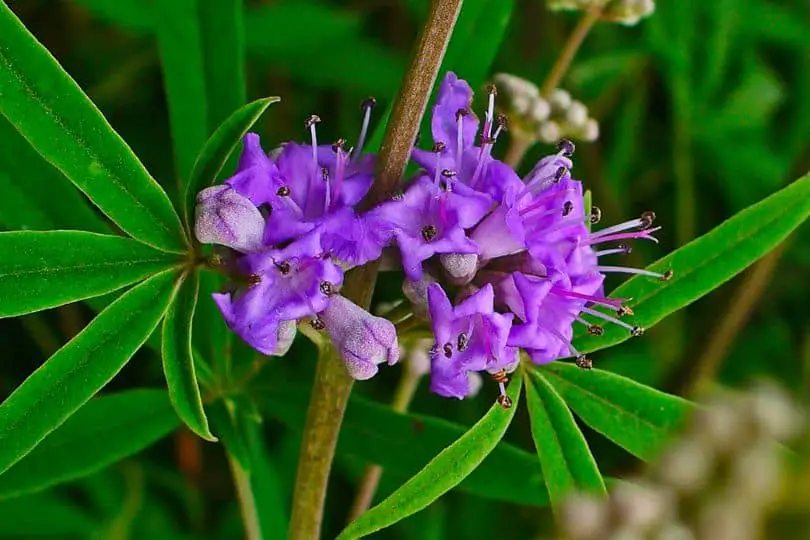
- Scientific Name: Vitex agnus-castus
- Common Name(s): Chaste Tree
- Mature Height: 10-20 feet (3-6 meters)
- Native Region: Mediterranean region
- Flowers: Lavender-blue upright spikes
- Fruit: Small, round, dark purple berries
- Uses: Ornamental tree, attracts pollinators, herbal medicine for hormonal balance.
The Chaste Tree (Vitex agnus-castus) is a deciduous tree that grows to a mature height of 10 to 20 feet (3 to 6 meters). It is native to the Mediterranean region, although it can also be found in Pennsylvania. Because of its lovely flowers and foliage, the Chaste Tree is a popular ornamental tree.
In the summer, the Chaste Tree is recognized for its striking lavender-blue erect spikes of flowers. Bees, butterflies, and other pollinators are drawn to these blooms. The scent of the flower spikes is frequently described as spicy or peppery. The blooms are spectacular, and this tree would look lovely in any landscape.
The Chaste Tree produces small, spherical, dark purple berries when the petals fade. These berries add to the visual appeal of the tree. It is crucial to emphasize, however, that the berries are not edible and should not be consumed.
In Pennsylvania environments, the Chaste Tree is relatively simple to grow and care for. It enjoys full light but may tolerate partial shade. This tree can grow in a variety of soil types, including clay, loam, and sandy soil. Once established, it is also drought tolerant. Because the Chaste Tree blooms on new wood, it should be clipped in late winter or early spring to keep its shape and encourage prolific flowering.
The Chaste Tree has been utilized in herbal medicine for its therapeutic benefits in addition to its decorative significance. It has a long history of usage in balancing hormones and treating PMS and menopausal symptoms. However, before utilizing any herbal medicines, it is critical to consult with a healthcare expert.
7. Purple Prince Crabapple
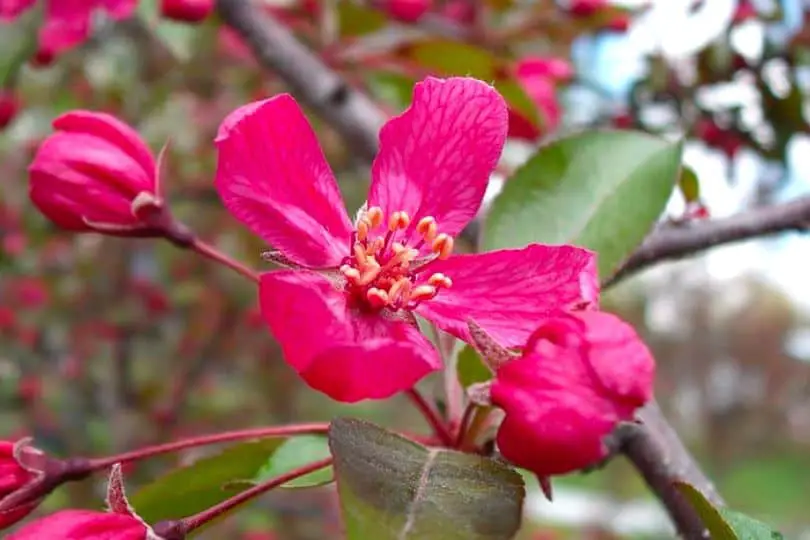
- Scientific Name: Malus ‘Purple Prince’
- Common Name(s): Purple Prince Crabapple
- Mature Height: 10-15 feet (3-4.5 meters)
- Native Region: North America
- Flowers: Deep pink, single or semi-double flowers
- Fruit: Small purplish-red crabapples
- Uses: Ornamental tree, attracts birds, wildlife food source, can be used in jams and jellies.
Malus ‘Purple Prince’ (Malus ‘Purple Prince’) is a tiny, decorative tree native to North America. It matures to a height of 10 to 15 feet (3 to 4.5 meters), making it ideal for smaller landscapes. This crabapple type is well-known for its beautiful deep pink blooms that emerge in the spring. The flowers are single or semi-double and provide an eye-catching display against the dark green foliage.
The Purple Prince Crabapple yields little purplish-red crabapples in the fall, in addition to its lovely blossoms. While the fruits are not commonly ingested by people due to their tart flavor, they are an important food source for birds and other wildlife. The modest size of the tree and its lovely fruits make it an excellent addition to bird gardens or naturalized areas.
The Purple Prince Crabapple can grow in a variety of soil types and tolerates both wet and dry conditions. It requires little care and can grow in full sun or light shade. This tree is hardy in USDA zones 4 to 8, making it ideal for Pennsylvania landscaping.
The Purple Prince Crabapple is grown for its fruits as well as for its decorative appeal. Crabapples can be used to make jams, jellies, or preserves, which will lend a tart flavor to your culinary creations.
8. Ornamental Pear
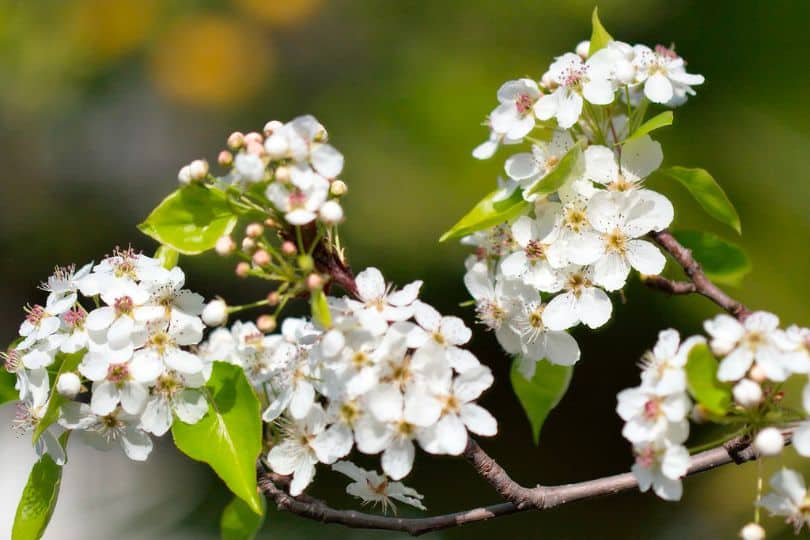
- Scientific Name: Pyrus calleryana
- Common Name(s): Ornamental Pear
- Mature Height: 40-50 feet (12-15 meters)
- Native Region: China and Vietnam
- Flowers: Clusters of white flowers in early spring.
- Fruit: Small, hard pears that are not usually edible.
- Uses: Often planted as a street or lawn tree for its attractive flowers and fall foliage.
Pyrus calleryana (Ornamental Pear) is a deciduous tree endemic to China and Vietnam. It is popular in Pennsylvania settings due to its lovely blossoms and fall leaves. This tree can grow to be 40-50 feet (12-15 meters) tall when mature.
When young, the Ornamental Pear has a pyramidal appearance, but as it ages, its branches begin to spread out. The glossy, oval-shaped leaves are dark green in hue and turn bright colors of crimson, orange, and purple in the fall. As the tree ages, the bark turns grayish-brown and develops shallow furrows.
The Ornamental Pear produces clusters of white blossoms that cover the entire tree in early spring, making a magnificent spectacle. These little blossoms have a lovely aroma. This tree, however, does not produce edible fruit; instead, it produces little, hard pears that are unfit for food.
The Ornamental Pear thrives in full sun and well-drained soil in Pennsylvania. It may grow in a variety of soil types, including clay and sandy soil. This tree is well-known for being low-maintenance and adaptable to urban areas. Because of its lovely blossoms, fall leaves, and adaptability to urban circumstances, it is frequently planted as a street or yard tree.
9. Star Magnolia
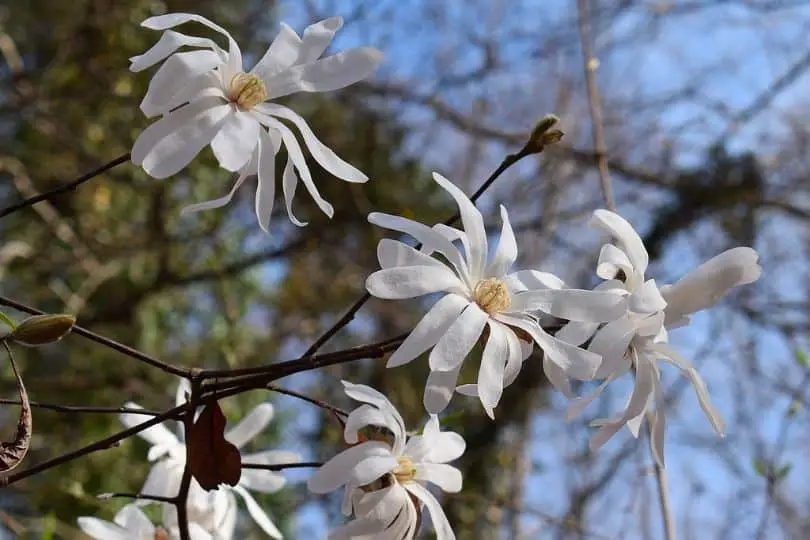
- Scientific Name: Magnolia stellata
- Common Name(s): Star Magnolia
- Mature Height: 10-15 feet (3-4.5 meters)
- Native Region: Japan
- Flowers: White, star-shaped flowers with a sweet fragrance
- Fruit: Cone-like structures with bright red seeds
- Uses: Ornamental tree, landscaping centerpiece, cut flowers for floral arrangements
The Star Magnolia, scientifically known as Magnolia stellata, is a Japanese deciduous tree. It grows to a mature height of 10 to 15 feet (3 to 4.5 meters). The tree is prized for its beautiful blossoms, which bloom in early spring before the leaves appear.
The huge, white, star-shaped blossoms of the Star Magnolia are easily identified. These blooms have many tepals, which are petal-like structures that give them a delicate appearance. The blossoms have a pleasant aroma, which adds to their allure.
The leaves of the Star Magnolia are simple, ovate-shaped, and slightly fuzzy. They are bright green and turn yellow before dropping off in the fall. The tree’s bark is smooth and grayish-brown.
The Star Magnolia grows in well-drained soil and prefers full sun to light shade in Pennsylvania landscaping. It is critical to water the tree regularly, especially during hot and dry months. Mulching around the base of the tree aids in moisture retention and keeps the roots cool.
The Star Magnolia is a beautiful decorative plant that is frequently used as a landscaping centerpiece. The tree’s beautiful blossoms make it a beautiful focal point in any garden or yard. Cut flowers are very widely utilized in floral arrangements due to their beauty and aroma.
10. Royal Empress Tree
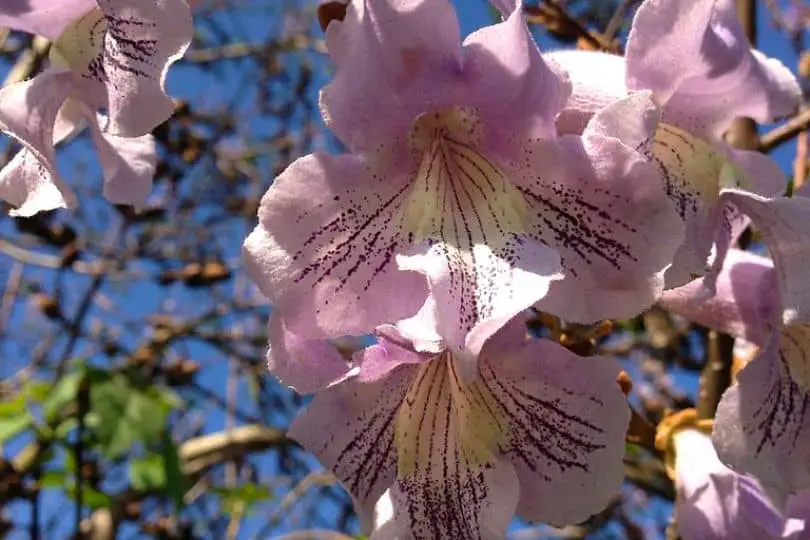
- Scientific Name: Paulownia tomentosa
- Common Name(s): Royal Empress Tree, Empress Tree, Princess Tree, Foxglove Tree
- Mature Height: 40-60 feet (12-18 meters)
- Native Region: China
- Flowers: Lavender or purple, bell-shaped flowers clustered in large panicles.
- Fruit: Large, brown capsules containing numerous small seeds.
- Uses: Ornamental tree, shade tree, timber production, erosion control, honey production.
The Royal Empress Tree, scientifically known as Paulownia tomentosa, is a deciduous tree native to China that grows quickly. It can grow to be 40 to 60 feet (12 to 18 meters) tall with a similarly wide canopy. The tree is distinguished by its huge, heart-shaped leaves, which can reach a diameter of a foot. Young trees have smooth, grayish-brown bark, whereas mature trees have a rough, furrowed appearance.
The Royal Empress Tree is grown in Pennsylvania settings mostly for its lovely and prolific blossoms. The tree blooms in late spring to early summer with clusters of lavender or purple bell-shaped flowers. The delicious aroma and nectar of these blooms, which are grouped in enormous panicles, attract bees, butterflies, and hummingbirds. A Royal Empress Tree in full blossom is a sight to behold.
The tree produces enormous, brown capsules containing a slew of little seeds. These capsules survive the winter and release their seeds in the spring. The Royal Empress Tree is well-known for its rapid growth and capacity to regenerate from seeds and cuttings. It enjoys full sun and well-drained soil, but it may thrive in a variety of environments, from dry to wet.
Because of its colorful blossoms and rapid growth, the Royal Empress Tree is often utilized as an ornamental tree in Pennsylvania. It can also be used as a shade tree in the summer, providing relief from the hot heat. The tree’s wood is lightweight and has been utilized in the manufacturing of lumber. Because of its rapid growth and deep root system, it is useful for erosion management, particularly in disturbed or degraded areas. Furthermore, the Royal Empress Tree’s blossoms are a rich source of nectar for honey production.
11. Crape Myrtle
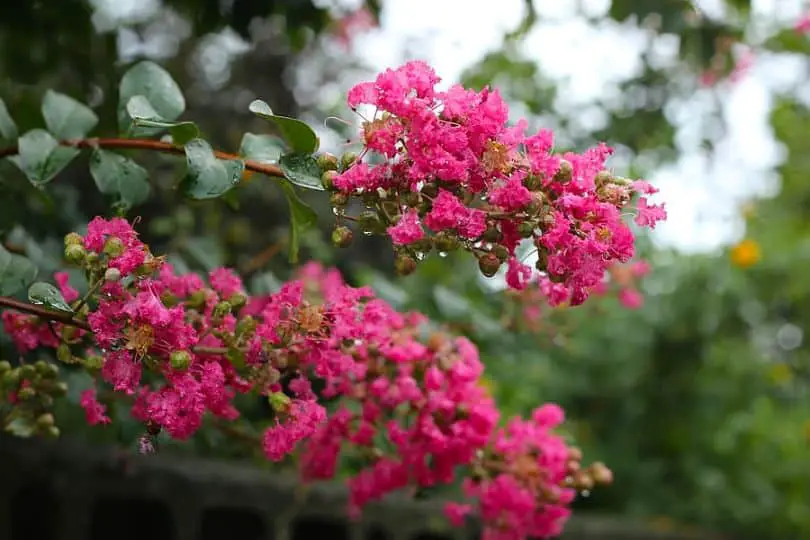
- Scientific Name: Lagerstroemia indica
- Common Name(s): Crape Myrtle
- Mature Height: 10 to 30 feet (3 to 9 meters)
- Native Region: Southeast Asia
- Flowers: Showy clusters of flowers in shades of pink, purple, red, and white. Flowers have crinkled petals, giving them a “crepe-like” appearance.
- Fruit: Small, round capsules that contain tiny seeds.
- Uses: Adds vibrant color to landscapes, commonly used as ornamental trees, and can be pruned to form hedges or screens.
The Crape Myrtle, or Lagerstroemia indica, is a prominent flowering tree in Pennsylvania settings. It is native to Southeast Asia but has spread to many other parts of the world. Crape Myrtle trees often grow to be 10 to 30 feet tall, making them ideal for tiny yards or as focal points in larger landscapes.
The gorgeous flower clusters of Crape Myrtle trees are one of their distinguishing characteristics. They bloom in the summer and are available in a range of colors, including pink, purple, red, and white. The crinkled petals of the blooms give them a distinct and unusual appearance, akin to crepe paper, hence the name “Crape Myrtle.” These brilliant flowers produce a striking display and attract butterflies and pollinators to the garden.
Crape Myrtle trees, in addition to their beautiful flowers, generate small, round capsules containing microscopic seeds. These fruits are not very noteworthy or valuable in terms of consumption or utility.
Crape Myrtle trees are ideal for Pennsylvania settings because they withstand a wide range of soil types and require little upkeep. To optimize flower output, they require full sun exposure but may readily tolerate partial shade. Their growth requires adequate moisture and well-drained soil. Pruning can be done in the early spring to keep the trees’ shape and size.
Crape Myrtle trees are extensively employed as decorative trees in Pennsylvania, bringing brilliant color and aesthetic interest to gardens, parks, and streetscapes. They can be grown as individual specimens, as a focal point in a mixed border, or pruned to produce hedges and screens. Crape Myrtle trees can thrive and provide beauty to Pennsylvania landscapes for many years if properly cared for and maintained.
12. Red Buckeye
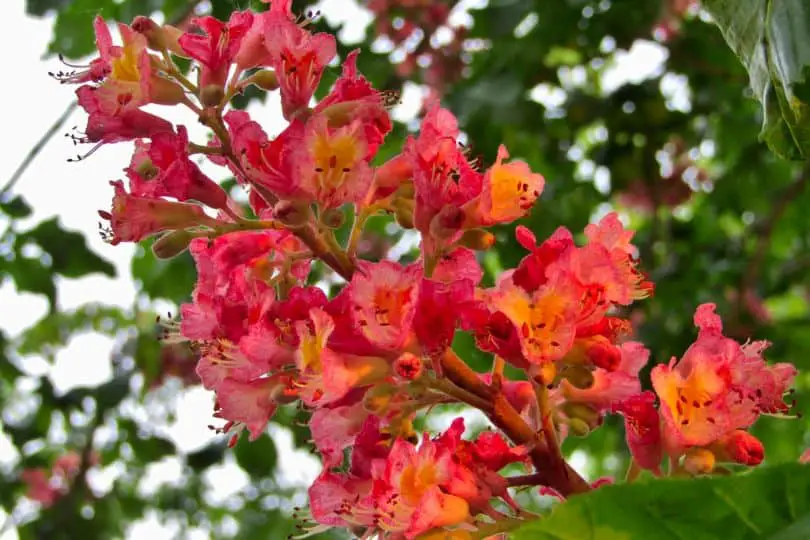
- Scientific Name: Aesculus pavia
- Common Name(s): Red Buckeye
- Mature Height: 10-20 feet (3-6 meters)
- Native Region: Eastern United States
- Flowers: Red tubular flowers arranged in clusters, attracting hummingbirds and butterflies.
- Fruit: Smooth round capsules that contain shiny brown seeds.
- Uses: Ornamental tree, attracts pollinators, provides shade.
The Red Buckeye, also known as Aesculus pavia, is a tiny deciduous tree native to the eastern United States, including Pennsylvania. When completely matured, it can reach a height of 10-20 feet (3-6 meters). This tree is noted for its gorgeous red tubular blooms, which bloom in clusters in early spring and are known to draw hummingbirds and butterflies to the landscape.
The canopy of the Red Buckeye is rounded, with dark green leaves that turn yellow in the fall. Its bark is smooth and brown-gray in hue, which adds to the tree’s overall beauty. This tree grows in damp woodland regions, along streams, and in well-drained soils.
The Red Buckeye has eye-catching red tubular blooms that are grouped in tall pyramidal clusters. The blossoms attract pollinators like hummingbirds and butterflies, making it a good choice for wildlife-friendly environments. The blooms bloom in early spring, adding a dash of color to the scene.
Smooth round capsules with lustrous brown seeds are produced by the tree. When grown, these seeds can be planted to create new Red Buckeye trees. This tree grows best in well-drained soil and light shade, however, it may also survive the full sun. Adequate moisture is required during the tree’s initial establishment.
Because of its gorgeous blossoms and overall pleasing appearance, the Red Buckeye is frequently utilized as an ornamental tree in Pennsylvania landscaping. It can be grown as a single specimen, in groups, or as a boundary tree. It adds value to any garden or landscape by attracting pollinators. The dense foliage of the Red Buckeye also provides shade, making it an excellent choice for outdoor lounging spaces or patios.
13. Japanese Stewartia
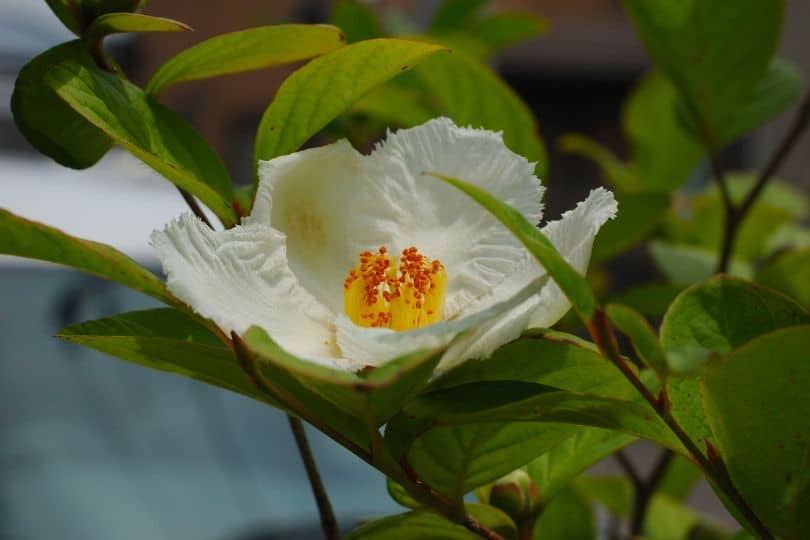
- Scientific Name: Stewartia pseudocamellia
- Common Name(s): Japanese Stewartia
- Mature Height: 20-40 feet (6-12 meters)
- Native Region: Japan, Korea
- Flowers: White, camellia-like flowers with a yellow center
- Fruit: Small, brown capsule-like fruits
- Uses: Ornamental tree, popular in gardens and landscapes for its attractive flowers and foliage.
Japanese Stewartia (Stewartia pseudocamellia) is a blooming deciduous tree native to Japan and Korea. It normally matures at a height of 20 to 40 feet (6 to 12 meters) and grows at a moderate rate. The tree is famous for its lovely camellia-like blossoms with white petals and a bright yellow center. These magnificent blossoms give a touch of class to any setting.
Japanese Stewartia has several appealing characteristics in addition to its gorgeous blossoms. Its oval-shaped, brilliant green leaves become gorgeous colors of crimson and orange in the fall. Smooth and exfoliating in sections, the bark reveals a colorful pattern of green, gray, and brown. This distinctive bark gives visual interest to the tree, especially when the leaves have fallen.
Japanese Stewartia grows in wet forests and along streambanks in its natural area. It favors well-drained soils and light shade but may survive full sun with enough rainfall. To achieve optimal growth, treat the tree with rich, acidic soil and consistent hydration in Pennsylvania landscapes. Mulching around the tree’s base keeps the soil moist and insulates the roots during the winter.
Japanese Stewartia is extensively planted as an ornamental tree in gardens and landscapes due to its visual appeal. Its beautiful blossoms make it a focus point in any garden, bringing elegance and charm. The autumn foliage is particularly spectacular, making this a distinctive tree in the environment. Furthermore, the distinctive bark gives interest to the winter garden.
14. Fire Cherry
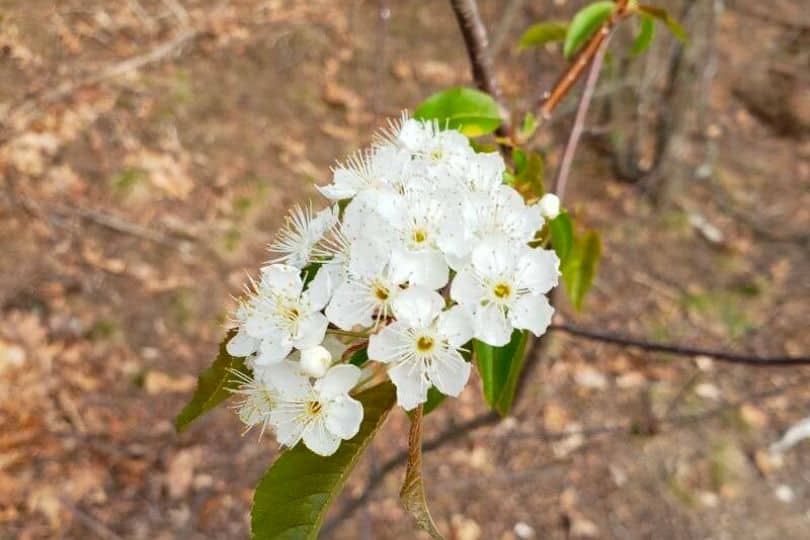
- Scientific Name: Prunus pensylvanica
- Common Name(s): Fire Cherry, Bird Cherry, Pin Cherry
- Mature Height: 15-30 feet (4.6-9.1 meters)
- Native Region: North America
- Flowers: Clusters of small white flowers appear in early spring.
- Fruit: Small bright red cherries that are popular with birds.
- Uses: Fire Cherry is often used in landscaping for its attractive white flowers and vibrant red cherries. It is also a valuable wildlife plant, as the cherries provide food for birds and other animals.
The Fire Cherry (Prunus pensylvanica) is a tiny North American deciduous tree. It can reach a height of 15-30 feet and has a slender, upright shape with many trunks. The tree is well-known for its lovely white blossoms, which appear in clusters and bloom in early spring, bringing a splash of color to the scene.
Fire Cherry is widely found in open forests, along stream banks, and in disturbed regions in Pennsylvania. Its natural range is from the northeastern United States to western Canada. The tree may grow in a variety of soil types but prefers well-drained, acidic soils.
The Fire Cherry’s leaves are simple, alternating, and ovate. They have serrated edges and are dark green in hue, becoming yellow in the fall. Young trees have smooth, reddish-brown bark, whereas adult trees have a scaly texture and a darker tint.
The fruit of the Fire Cherry is one of its most distinguishing characteristics. The little cherries ripen in late summer and are vivid red. They are favored by birds, which aid in seed dispersal. Because of their acidic flavor and small size, cherries are not typically consumed by humans.
Fire Cherry is a low-maintenance tree that thrives in a wide range of growth situations. It prefers direct sunlight but may tolerate moderate shade. To establish deep roots, the tree requires constant irrigation, especially during dry months. Pruning is not normally required, however, it can be done in early spring to keep a desirable shape.
Fire Cherry is frequently utilized in landscaping to offer variety to woodland gardens or native areas. Pollinators are drawn to its white blossoms, and the cherries provide food for wildlife. The tree is extremely decorative in the fall, when its leaves turn yellow, creating a stunning contrast with the red cherries.
15. Serviceberry
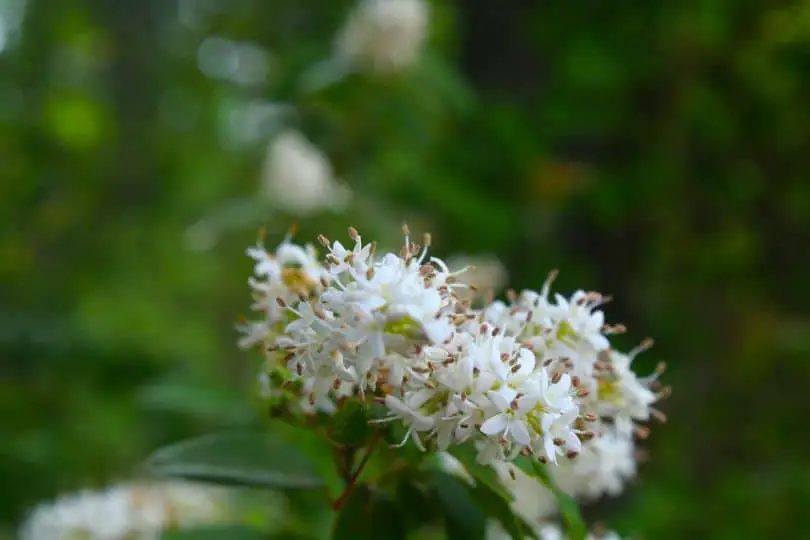
- Scientific Name: Amelanchier spp.
- Common Name(s): Serviceberry, Juneberry, Shadbush
- Mature Height: 15-30 feet (4.6-9.1 meters)
- Native Region: North America
- Flowers: White or pink, star-shaped flowers in early spring
- Fruit: Edible berries that ripen in summer, resembling blueberries
- Uses: Ornamental tree, wildlife attractant, edible fruit for humans and wildlife, used in jams, jellies, and pies
The Serviceberry (Amelanchier spp.) is a tiny deciduous tree or shrub that is abundant in Pennsylvania landscapes. It grows to a mature height of 15 to 25 feet (4.5 to 7.6 meters) and creates a multi-stemmed cluster, making it an ideal choice for naturalizing or adding interest to the garden.
Serviceberries are native to North America and thrive in the climate of Pennsylvania. They love moist, well-drained soil and grow in full sun to partial shade. These trees are well-known for their showy display of white, star-shaped flowers in early spring, which give way to dark purple berry-like fruits that are edible and popular with both humans and wildlife.
Serviceberries have oval-shaped leaves that emerge golden to green before changing yellow to orange in the fall. The tree’s smooth gray bark contributes to its visual appeal. Serviceberries are popular as ornamentals because they have a delicate beauty that lasts through the seasons.
Serviceberries have various functional uses aside from their visual attractiveness. The fruits can be gathered and eaten fresh or used in pies, jams, and jellies. The tree also serves as an important food source for birds and other species. Serviceberries also have a strong root system that helps with erosion prevention, making them an excellent choice for planting on slopes or along stream banks.
It is critical to offer frequent irrigation to Serviceberries in Pennsylvania landscapes, especially during dry years. Mulching around the tree’s base can assist in preserving moisture and inhibit weed growth. Pruning should be performed in late winter or early spring to remove dead or broken branches and, if desired, shape the tree.
16. Hawthorn
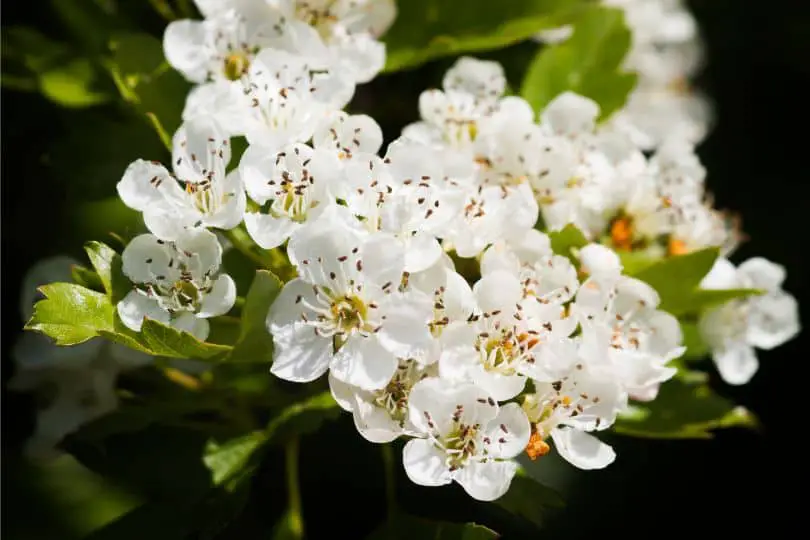
- Scientific Name: Crataegus spp.
- Common Name(s): Hawthorn
- Mature Height: 10-40 feet (3-12 meters)
- Native Region: North America, Europe, Asia
- Flowers: White, pink, or red flowers, usually 1 inch in diameter, in clusters.
- Uses: Hawthorn trees are commonly used as ornamental trees in landscapes. They provide beautiful flowers in spring and also produce small fruit which can attract wildlife. Some species are also used in traditional medicine for their potential cardiovascular benefits.
Hawthorn is a well-known tree in the Crataegus genus. Its natural range includes North America, Europe, and Asia. Hawthorn trees are medium-sized, growing to a height of 10-40 feet (3-12 meters), with a rounded crown. Because of their dense and thorny growth pattern, these trees are ideal for forming barriers or hedges.
Hawthorn trees are easily recognizable in Pennsylvania landscapes by their lobed, dark green leaves. Mature tree bark is grayish-brown and gets tough with age. Hawthorns are well-known for their lovely, fragrant blossoms that bloom in the spring. The flowers are typically 1 inch in diameter and white, pink, or red in hue. They bloom in bunches, making for a spectacular display when fully bloomed.
Hawthorn trees yield little fruit known as haws when they flower. These fruits, which are usually red, are eaten by birds and small mammals. The fruits of the tree can remain on the tree until late autumn or even winter, giving visual appeal to the environment.
Hawthorn trees can grow in a variety of soil types and handle both full sun and moderate shade. They like well-drained soil but may withstand a little moisture. Once planted, these trees are generally hardy and require little maintenance. Traditional medicine uses some hawthorn species for their potential cardiovascular benefits.
Hawthorn trees are often planted as attractive trees in residential and commercial settings in Pennsylvania. They are treasured for their beautiful flowers and fruit, as well as their capacity to attract wildlife. Hawthorn trees also provide bird nesting areas and cover. Some species are also employed in hedgerows to form natural boundaries and windbreaks.
17. Basswood
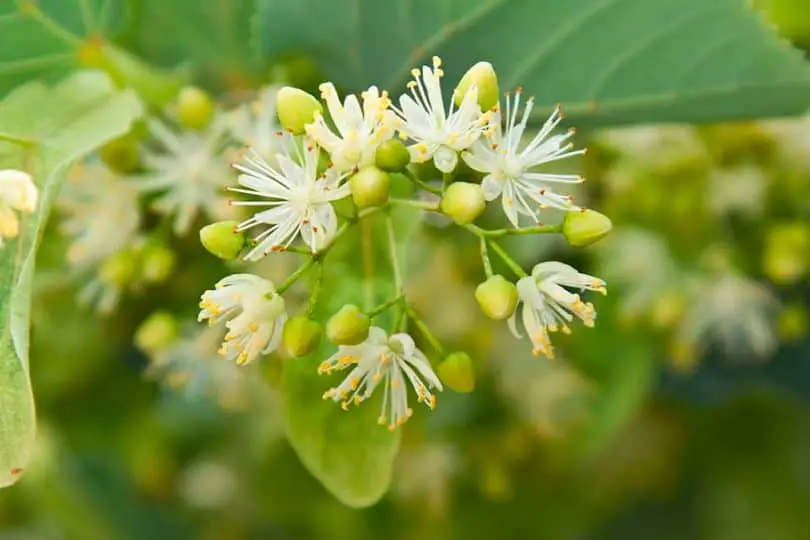
- Scientific Name: Tilia americana
- Common Name(s): Basswood, American basswood, American linden
- Mature Height: 60-80 feet (18-24 meters)
- Native Region: Eastern and Central North America
- Flowers: The fragrant, pale yellow flowers are small and bell-shaped, hanging in clusters. They bloom in late spring to early summer.
- Uses: Basswood is often planted as an ornamental tree in landscapes for its attractive shape, large leaves, and fragrant flowers. The tree is also valued for its soft, lightweight wood, which is used in the production of furniture, millwork, and carvings.
Basswood is a deciduous tree that can grow to heights of 60 to 80 feet. It is also known as American basswood or American linden. It features a broad, rounded base and a symmetrical, pyramidal top. Grayish-brown bark with deep furrows and flat ridges. The leaves are huge, heart-shaped, and dark green, and they provide significant shade beneath the tree. The leaves turn a vivid golden in the fall.
Basswood, which is native to Eastern and Central North America, is widely seen in Pennsylvania settings. It prefers full sun to light shade and grows best in moist, well-drained soils. Because of its appealing shape and huge leaves, it is frequently planted as an ornamental tree.
The aromatic blossoms of the basswood tree are one of its most prominent characteristics. The tree produces little, pale yellow blooms that dangle in clusters from late spring to early summer. The bell-shaped blossoms have a pleasant, honey-like aroma that attracts bees and other pollinators. The nectar from the blooms is also utilized to make premium honey.
As the petals fade, little round fruits known as nutlets appear. These nutlets are linked to a strap-like bract, giving them a distinct appearance. While they are not particularly attractive, they provide food for wildlife such as squirrels and birds.
Basswood has a variety of applications aside from its visual appeal. The tree’s soft, lightweight wood is frequently utilized in the manufacture of furniture, millwork, and sculptures. It is simple to work with and accepts finishes well. Basswood’s inner bark can also be extracted and used for weaving, mats, baskets, and cordage.
18. Tuliptree
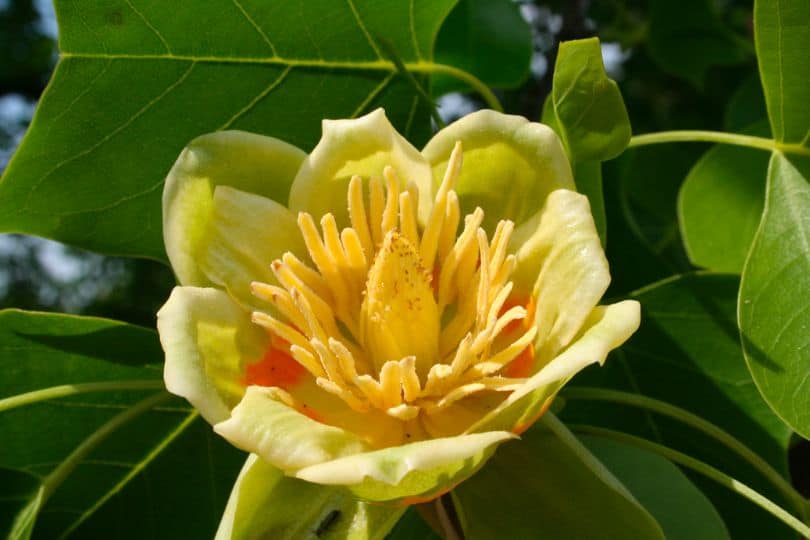
- Scientific Name: Liriodendron tulipifera
- Common Name(s): Tuliptree, Tulip Poplar, Yellow Poplar
- Mature Height: 70-90 feet (21-27 meters)
- Native Region: Eastern North America
- Flowers: Large, tulip-shaped flowers with yellow-green petals, orange at the base, and sometimes faint orange streaks in the middle.
- Fruit: Cone-shaped brown fruits with numerous winged seeds.
- Uses: The wood is used for furniture, cabinetry, and veneer. The flowers attract bees for honey production, and the tree provides shade and ornamental value in landscapes.
The Tuliptree (Liriodendron tulipifera) is a huge deciduous tree native to the eastern section of North America, including Pennsylvania. It is also known as Tuliptree, Tulip Poplar, or Yellow Poplar. This tree can grow to be 70-90 feet (21-27 meters) tall and has a unique pyramidal shape while young, later growing a broad and open crown with age.
The Tuliptree is easily identified by its distinctive leaves, which are alternating, simple, and four-lobed, like a tulip. In the fall, they become a vivid yellow, adding to the tree’s visual appeal. As the Tuliptree ages, its smooth grayish-brown bark becomes ridged and furrowed.
The Tuliptree is typically found in moist, well-drained soils in river valleys, bottomlands, and highland forests in Pennsylvania. This species is well-known for its quick growth and necessitates full sun to thrive. It is adaptable to a variety of soil types but likes deep, loamy soils with adequate drainage.
The blossoms of the Tuliptree are one of its most distinctive characteristics. The huge tulip-shaped flowers, which appear in late spring to early summer, are about 2 inches (5 cm) long and feature yellow-green petals with an orange base. Some flowers may have light orange streaks in the center. The aromatic blossoms attract bees, which help with pollination and honey production.
The Tuliptree produces cone-shaped brown fruits with numerous winged seeds as the flowers fade. Wind disperses these seeds, allowing the tree to spread and occupy new places.
The Tuliptree is treasured in Pennsylvania landscapes for its decorative appeal and shade-giving characteristics. It is a popular choice for parks, larger yards, and street plantings due to its spectacular blossoms and vibrant autumn foliage. Tuliptree wood is lightweight, robust, and relatively durable, making it useful for a range of applications including furniture, cabinetry, and veneer manufacture.
19. Witch Hazel
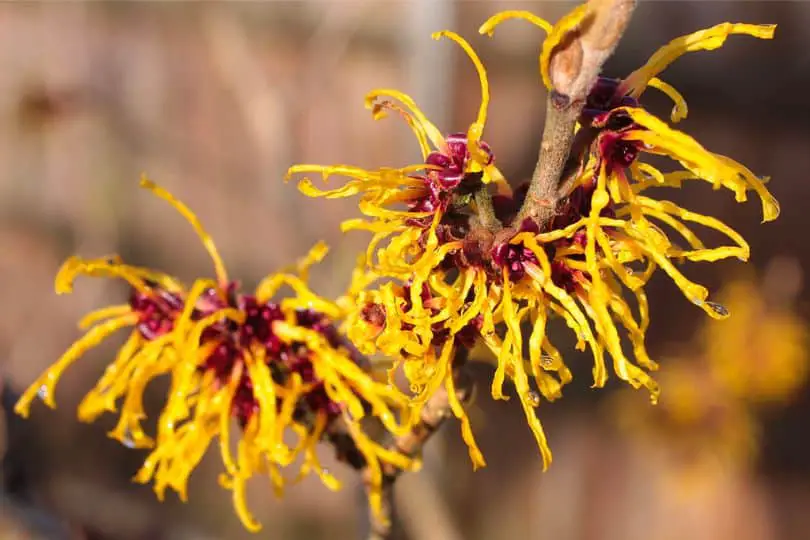
- Scientific Name: Hamamelis virginiana
- Common Name(s): Witch Hazel
- Mature Height: 10-25 feet (3-8 meters)
- Native Region: North America
- Flowers: Witch Hazel produces yellow, fragrant flowers in late fall to early winter, which is unique as most plants bloom in spring or summer. The flowers consist of slender, thread-like petals, giving them a distinctive appearance.
- Fruit: Witch Hazel produces small woody capsules that contain seeds.
- Uses: Witch Hazel is commonly used in skincare products due to its astringent and anti-inflammatory properties. It is also used in traditional medicine for its medicinal properties, including treating skin irritations, sunburn, and hemorrhoids.
Witch Hazel is a tiny deciduous tree or shrub that develops to be 10-25 feet tall. It has a spreading habit and a rounded irregular appearance. The leaves are oblong, alternating, and toothed. The leaves turn yellow and fall off in the autumn, displaying the tree’s distinctive blossoms.
Witch Hazel is a North American native that can be found in the eastern United States, including Pennsylvania. It prefers moist, well-drained soil and may grow in a variety of environments, from full sun to light shade.
The late-season flowering of Witch Hazel is one of its most notable characteristics. Witch Hazel blooms in late fall to early January, whereas most plants bloom in the spring or summer. The fragrant yellow blossoms develop before the leaves, bringing a burst of color to the winter scene. The petals of the flower are long and slender, resembling thread-like ribbons. Because of its distinctive blossoming season, Witch Hazel is a fantastic choice for bringing interest and beauty to Pennsylvania landscapes throughout the colder months.
In addition to its beautiful blossoms, Witch Hazel produces little woody capsules containing seeds. These capsules survive the winter and give aesthetic appeal to the tree.
Witch Hazel is a multi-purpose tree that can be used for both aesthetic and practical purposes. Its lovely blossoms make it an appealing addition to gardens and natural environments, adding a splash of color during the winter months. Furthermore, Witch Hazel extract has a wide range of applications. Because of its astringent and anti-inflammatory characteristics, it is a common ingredient in skincare products. Witch Hazel extract is known for its ability to soothe and calm sensitive skin, making it an ideal natural cure for a variety of skin ailments. It is also used to cure sunburn, bug bites, and hemorrhoids in traditional medicine.
20. Black Locust
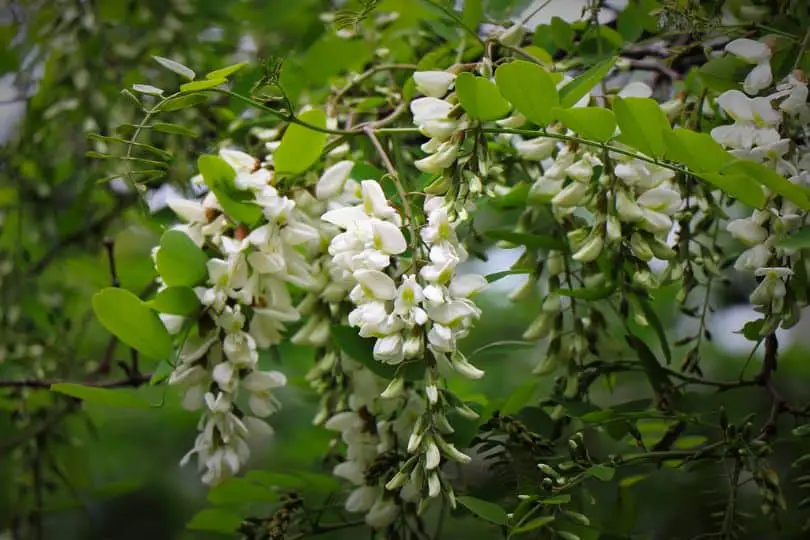
- Scientific Name: Robinia pseudoacacia
- Common Name(s): Black Locust, False Acacia, Yellow Locust
- Mature Height: 30-80 feet (9-24 meters)
- Native Region: North America
- Flowers: White, fragrant, pea-like flowers in hanging clusters
- Fruit: Brown pods containing seeds
- Uses: Timber, erosion control, wildlife habitat, honey production, ornamental planting, medicinal purposes
The Black Locust, technically known as Robinia pseudoacacia, is a deciduous tree native to Pennsylvania. It is endemic to North America and can grow to a mature height of 30-80 feet (9-24 meters). The Black Locust is well-known for its distinct traits and varied applications.
This tree is distinguished by its compound leaves, which are composed of several leaflets grouped in pairs along a central stem. The Black Locust’s bark is usually dark gray and heavily furrowed, giving it a rough texture. It is commonly found in open forests, along roadsides, and in disturbed regions in Pennsylvania.
The Black Locust’s stunning white blossoms, which appear in late spring or early summer, are one of its most notable characteristics. These fragrant flowers are clustered in pendulous clusters that resemble little, pea-like blossoms. The blossoms attract pollinators such as bees and butterflies, making it an excellent choice for any garden or landscape.
The Black Locust produces elongated brown pods with seeds after the flowering season. These pods provide a significant source of food for wildlife, particularly birds and small mammals. The tree’s hard, rot-resistant wood makes it a popular choice for timber, which is widely used for fence posts, outdoor furniture, and buildings.
The Black Locust is commonly planted for erosion prevention in Pennsylvania because its vast root system helps maintain soil on slopes. It also provides important wildlife habitat, especially for songbirds. Furthermore, the Black Locust blossoms provide nectar for bees, who make a highly sought and tasty honey.
The Black Locust grows at a moderate rate and tolerates a wide range of soil conditions, however, it favors well-drained soils. Once grown, it can resist drought and is relatively low-maintenance. Because of its lovely blossoms and ability to give summer shade, this tree is widely utilized for decorative purposes. However, be cautious because Black Locusts can be invasive in some areas.
21. Catalpa
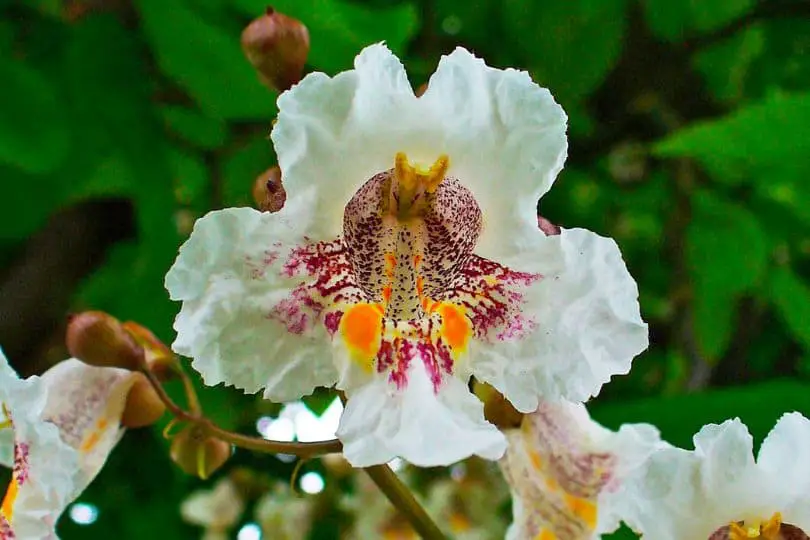
- Scientific Name: Catalpa spp.
- Common Name(s): Catalpa, Indian Bean Tree
- Mature Height: 30-60 feet (9-18 meters)
- Native Region: North America
- Flowers: White, trumpet-shaped flowers with purple and yellow spots inside.
- Fruit: Long, cylindrical bean-like pods.
- Uses: Ornamental tree, shade tree, timber.
Catalpa is a flowering tree genus endemic to North America. Catalpa or Indian Bean Tree are typical names for them. When completely grown, these trees can reach heights of 30 to 60 feet (9 to 18 meters). They are extensively grown for their decorative value, producing lovely white flowers in late April.
Catalpa trees feature deep green leaves that are big and heart-shaped. As the tree matures, the bark turns light gray and develops deep furrows.
Large, exquisite blossoms are what set Catalpa trees apart. The fragrant flowers have white trumpet-shaped petals with purple and yellow dots inside. These flowers are attractive to bees and other pollinators, making them an important component of pollinator gardens.
Catalpa trees produce long, cylindrical bean-like pods with numerous flat seeds in late summer. Throughout the winter, the pods remain on the tree, providing interest and texture to the environment. For best growth, this tree likes well-drained soil and full sun exposure. It adapts to a variety of soil types but flourishes in damp, fertile soil.
Catalpa trees are extensively planted as attractive trees in Pennsylvania landscapes and parks. With its huge canopy, they give plenty of shade, making them excellent for hot summer days. Furthermore, their eye-catching blossoms and distinctive seed pods provide visual interest to gardens. Catalpa tree wood is strong and rot-resistant, making it ideal for fence posts, boat building, and other outdoor uses.
Similar Articles
- Common Maple Trees In Pennsylvania
- Common Cherry Trees In Pennsylvania
- Common Pine Trees In Pennsylvania
- Native Locust Trees In Pennsylvania
- Common Nut Trees In Pennsylvania
- Common Cedar Trees In Pennsylvania
- Common Palm Trees In Pennsylvania
- Common Birch Trees In Pennsylvania
- Common Aspen Trees In Pennsylvania
- Common Oak Trees In Pennsylvania
- Common Ash Trees In Pennsylvania
- Common Elm Trees In Pennsylvania
- Common Spruce Trees In Pennsylvania
- Pink Flowering Trees In Pennsylvania
- White Flowering Trees In Pennsylvania
- Purple Trees In Pennsylvania
Flowering Trees In Pennsylvania – Sources
The Regional Gardening team makes sure that the information in our articles is accurate by only using sources that are known to be trustworthy. Some of these sources are peer-reviewed journals from government agencies, well-known universities, and scientific research organizations.
- Native Plant Resources, Pennsylvania Native Plant Society
- Trees & Shrubs Varieties, PennState Extension
- Landscaping With Natives, Pennsylvania Department Of Conservation, & Natural Resources
- Explore Pennsylvania Forests, Pennsylvania Department Of Conservation, & Natural Resources


